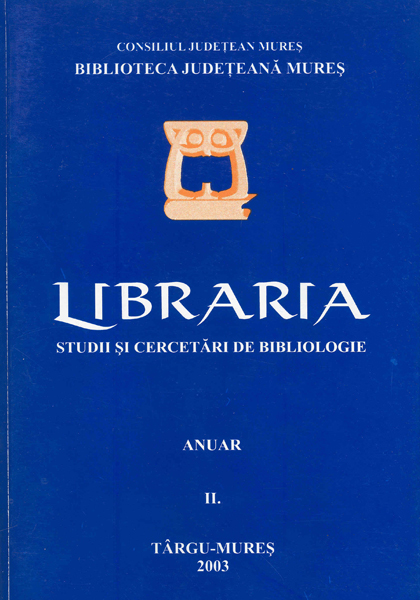Palia de la Orăştie şi Biblia de la Blaj – monumente de seamă ale literaturii religioase româneşti
Palia de la Orăştie and Biblia de la Blaj – Important Monuments of Romanian Religious Literature
old book
Author(s): Florica_Elisabeta NUŢIUSubject(s): Library and Information Science, Preservation, Other
Published by: Biblioteca Județeană Mureș
Keywords: Libraria; Biblioteca Județeană Mureș; biblioteconomie; bibliologie; carte veche; carte bibliofilă; istorie locală; servicii de bibliotecă; Biblioteca Teleki; carte veche românească;
Summary/Abstract: There is no doubt that the Bible is one of the most important and valuable books mankind ever had. It is structured in two parts: the first one, known as the Old Testament, has been translated for the first time in Greek in the 3rd century B.C. by a number of seventy scholars. Today we call it Septuaginta. Seven hundred years later, thanks to Saint Jeronimus, the two parts of the Bible - Old and New Testament – have been translated together. This first integral variant, in Latin, is today known as Vulgata.The first Romanian translations of the Bible dates from the 16th century and they have a double meaning: they reflect the religious disagreements and, on the other hand, they are considered to be birth certificates of Romanian literary language. Palia de la Orăştie is the last translation of the Bible that has been published in Romanian language in the 16th century (1581-1582). It contains the first two chapters of Old Testament and had an important place in language formation. It is known that it could have been translated and published thanks to the Calvinist propaganda of Hungarians from Transylvania. Biblia de la Blaj was printed in 1795 and it was inspired by Biblia de la Bucureşti from 1688. It is also known as Biblia lui Samuil Micu and soon became the national Bible of all Romanians.A linguistic comparison between the two books reveals the role they had in the process of language formation. There are some interesting aspects that we may find: the use of old-fashioned words along with new expressions; a mixture of direct and indirect speech; the words used in both books belong to the Romanian basic word stock; the use of numerous synonims (from 3 to 11) in order to express the various meanings of the words. We can also find some differences: while Palia emphasizes the western Romanian dialect, Biblia is strongly influenced by the northern aspects of language; Palia uses the specific language of the religious works of the 16th century; Biblia illustrates the tendencies of language unification during the 18th century.
Journal: Libraria. Studii și cercetări de bibliologie
- Issue Year: II/2003
- Issue No: 2
- Page Range: 155-166
- Page Count: 12
- Language: Romanian

